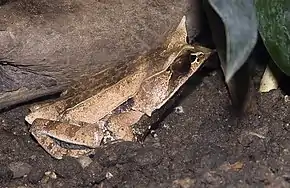Mesobatrachia
Mesobatrachia est un sous-ordre d'amphibiens anoures primitifs, de la classification classique. Les récentes analyses ont démontré que ce taxon était paraphylétique.
Liste des familles
- famille Megophryidae Bonaparte, 1850
- famille Pelobatidae Bonaparte, 1850
- famille Pelodytidae Bonaparte, 1850
- famille Pipidae Gray, 1825
- famille Rhinophrynidae Günther, 1859
- famille Scaphiopodidae Cope, 1865
Phylogénie
Les familles de ce sous-ordre paraphylétique sont celles placées au sein du clade Pipanura, mais en dehors du sous-ordre Neobatrachia. Les familles placées à la base en dehors de Pipanura forment le sous-ordre Archaeobatrachia (paraphylétique également).
Cladogramme d'après Frost et al. (2006)[1], Heinicke et al. (2009)[2] ainsi que Pyron et Wiens (2011)[3]:
Phylogénie des familles basales de l'ordre Anura, d'après Pyron et Wiens (2011)[4] ainsi que Frost et al. (2006)[5] et Heinicke et al. (2009)[6] pour les noms de clades :
|
Notes et références
- (en) D. R. Frost, T. Grant, J. N. Faivovich, R. H. Bain, A. Haas, C. L. F. B. Haddad, R. O. De Sá, A. Channing, M. Wilkinson, S. C. Donnellan, C. J. Raxworthy, J. A. Campbell, B. L. Blotto, P. Moler, R. C. Drewes, R. A. Nussbaum, J. D. Lynch, D. M. Green et W. C. Wheeler, « The Amphibian Tree of Life », Bulletin of the American Museum of Natural History, vol. 297, , p. 1–291 (DOI 10.1206/0003-0090(2006)297[0001:TATOL]2.0.CO;2)
- (en) Heinicke M. P., Duellman, W. E., Trueb, L., Means, D. B., MacCulloch, R. D. et Hedges, S. B., « A new frog family (Anura: Terrarana) from South America and an expanded direct-developing clade revealed by molecular phylogeny », Zootaxa, vol. 2211, , p. 1–35 (lire en ligne)
- (en) R. Alexander Pyron et John J. Wiens, « A large-scale phylogeny of Amphibia including over 2800 species, and a revised classification of extant frogs, salamanders, and caecilians », Molecular Phylogenetics and Evolution, vol. 61, no 2, , p. 543–583 (PMID 21723399, DOI 10.1016/j.ympev.2011.06.012, lire en ligne)
- (en) R. Alexander Pyron et John J. Wiens, « A large-scale phylogeny of Amphibia including over 2800 species, and a revised classification of extant frogs, salamanders, and caecilians », Molecular Phylogenetics and Evolution, vol. 61, no 2, , p. 543–583 (PMID 21723399, DOI 10.1016/j.ympev.2011.06.012, lire en ligne)
- (en) D. R. Frost, T. Grant, J. N. Faivovich, R. H. Bain, A. Haas, C. L. F. B. Haddad, R. O. De Sá, A. Channing, M. Wilkinson, S. C. Donnellan, C. J. Raxworthy, J. A. Campbell, B. L. Blotto, P. Moler, R. C. Drewes, R. A. Nussbaum, J. D. Lynch, D. M. Green et W. C. Wheeler, « The Amphibian Tree of Life », Bulletin of the American Museum of Natural History, vol. 297, , p. 1–291 (DOI 10.1206/0003-0090(2006)297[0001:TATOL]2.0.CO;2)
- (en) Heinicke M. P., Duellman, W. E., Trueb, L., Means, D. B., MacCulloch, R. D. et Hedges, S. B., « A new frog family (Anura: Terrarana) from South America and an expanded direct-developing clade revealed by molecular phylogeny », Zootaxa, vol. 2211, , p. 1–35 (lire en ligne)
Cet article est issu de Wikipedia. Le texte est sous licence Creative Commons - Attribution - Partage dans les Mêmes. Des conditions supplémentaires peuvent s'appliquer aux fichiers multimédias.
